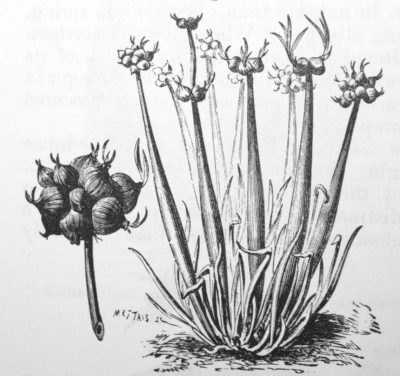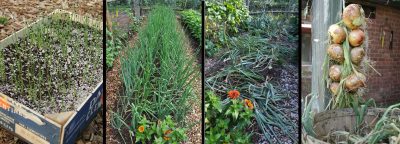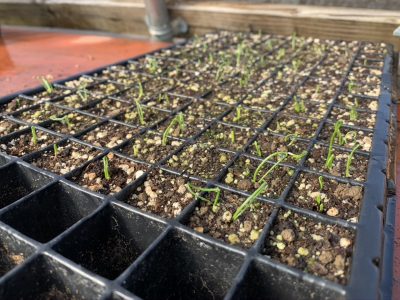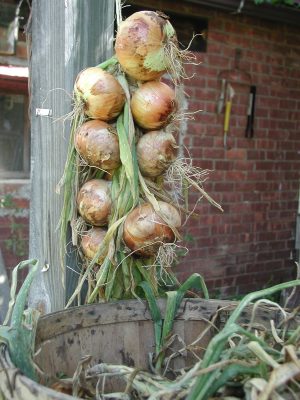ALL ABOUT ONIONS
An Ode
Onions, how do I plant thee? Let me count the ways. I plant thee just once for years of harvests if thou are the perennial potato or Egyptian onion. If thou are the pungent, but long-keeping, American-type onion, I sow thy seeds in the garden in the spring. And if I were to choose like most gardeners, I would plant thee in spring as those small bulbs called onion “sets.” (Apologies to E.B. Browning)
New Old Ways with Onions
Early March brings us to yet another way of growing onions: sowing the seeds indoors in midwinter. This was the “New Onion Culture” of a hundred and fifty years ago, and, according to a writer of the day, “by it the American grower is enabled to produce bulbs in every way the equal of those large sweet onions which are imported from Spain and other foreign countries.” This is the way to grow the so-called European-type onions.

Walking onions
What’s wrong with growing perennial onions, American-type onions, and onion sets? Neither perennial nor American-type onions have the sweet flavor of the famous Vidalia onion, a European type. And onions for sets are generally limited only to the two varieties marketed, Stuttgart and Ebenezer, whose important quality is that they make good sets. A few seeds companies sell sets of a better variety, Forum. In addition to variety, quality of sets is important: too large and they become useless as they send up seedstalks.
The New Onion Culture is a way to grow the large, sweet, mild European onions, such as Sweet Spanish.
The “Method” is as follows: About 10 weeks before the last hard freeze, fill a seed flat with potting soil and use a plant marker to make furrows 1/2-inch deep and one inch apart. Drop about seven seeds per inch into the furrows and then cover the seeds with soil. Fresh seed, less than a year old is best. Water the flat, then keep it moist and warm and covered with of pane of glass. The onions should sprout in a week or two.
Once the onions sprout, remove the plastic or glass and give the seedlings plenty of light. Put the flat either within a few inches of fluorescent lights, on a very sunny windowsill, or in a greenhouse. Each time the seedlings grow to six inches height, clip them back to four inches. The trimmings, incidentally, are very tasty. This indoor stage of plant growing can be bypassed by purchasing onion transplants (not sets), which are sold mail-order in bundles of twenty-five.
Get ready for transplanting a few weeks before the predicted last freeze date. Choose a garden spot where the soil is weed-free, well-drained, and bathed in sunlight. Onions demand high fertility; my plants go into a bed that was dressed with an inch depth of compost last fall. Give the onion seedlings their final haircut, tease their roots apart, then set them in a furrow, or individual holes dibbled with a 3/4-inch dowel. Plant seedlings two to four inches apart, two inches if you want small bulbs, four inches if you want big bulbs.

This may sound like a lot of trouble to grow onions. But for me, midwinter onion sowing inaugurates the new gardening season. The onion is an apt inaugural candidate; it responds to “high culture” starting with careful sowing in fertile soil and moving on to good weed control, timely watering, and, after harvest, correct curing after harvest.
Besides providing this midwinter ritual, onions raised according to the New Onion Culture do have superb flavor.
(The above was adapted from my book A Northeast Gardener’s Year.)
And Still Newer Ways
And now for the “Newer Onion Culture”: American-type onions have the advantage of being better for long-term storage, and newer varieties also have very good flavor. My current favorites are Copra, Patterson, and New York Early. They also are “long day” onions, setting bulbs when the sun shines for 15 to 16 hours daily. “Short day” varieties, which are adapted to the South, would bulb up too soon around here, producing puny bulbs.
There’s more to the “Newer Onion Culture.” A couple of years ago, a local farmer, Jay, of Four Winds Farm, told me he gets good results by just planting seeds in furrows right out in the field.
And even more. Instead of planting 7 seeds per inch indoors in furrows in early March, sow them in flats of plastic “cells” with 4 seeds per cell (each cell is about an inch square).  When transplanting out in the garden, plant each cell with its seedlings intact, spacing them further apart than you would with individual transplants so their roots get adequate water and nutrition. As vegetable growing maven Eliot Coleman wrote in Four-Season Harvest, “the onions growing together push each other aside gently.”
When transplanting out in the garden, plant each cell with its seedlings intact, spacing them further apart than you would with individual transplants so their roots get adequate water and nutrition. As vegetable growing maven Eliot Coleman wrote in Four-Season Harvest, “the onions growing together push each other aside gently.”
Back to my original query: “Onions, how do I plant thee.” Many ways. I’ll do four out of the six ways this season.



I’m starting mine from seed this year for the first time. Thanks for the tips!
I went back and reread your previous post, February 21,2013. I’m a little confused about the day length. When starting onions from seed I have them indoors under grow lights. How long should they be under grow lights once sprouted? Or does it make any difference when they are only 5 weeks old? How old are yours when you put them outside?
I’ve often thought about how long onions should be under grow lights. I guess I would keep them on a short day, which is less than 10hours of light per day, so that they aren’t inclined to bulb up too soon. Keep in mind, though, that photoperiod really means 14 hours of absolute darkness for each 24 hour period. I don’t consider that anymore for my onions because they are raised in my greenhouse under natural light.
I’m trying onions for the first time this year, and I wish I knew about multi-sowing cells back then! The same goes for trimming the sets; if I’ve already put them in their bed (under row fabric), should I still cut them back? When is too late to start more?
Thanks!
No, don’t trim them. Actually, I’m not sure the reason for trimming except to keep them fro being too floppy in their seedling trays. The only reason I do it is because a vegetable specialist at the University of Wisconsin told me that’s what you do. It seems like it would cut back on photosynthesis.
I agree with the idea of trimming as it reduces floppiness and it makes the seedlings more manageable, less likely to tangle up with each other.
Except that it has to also weaken a plant somewhat. Perhaps insignificantly.
I’ve already started mine, but next year I may give Jay’s method a go. I have extremely limited indoor seed starting area with only a S facing window, no overhead light. So I plant my trays, wait until I see 50% or so germination…then out the flats go to a hay bale “greenhouse” against the S wall of my house. Last year I had incredible abundance, happy healthy plants using this method, for onions and many many other vegetables. Best of any way I’ve tried. But I have to be very patient and start everything a few weeks later than recommended. Access to actual rain, actual sunshine, and a few layers of row cover under the plastic if needed, seemed to make up for any “lost” time.
When you put out your onion transplants, what is the thickness of your seedlings? I started mine the first week of February and when I transplanted them in early April, they were the size of a fat toothpick. I only used natural light by the window and put them outside in my mini-greenhouse made from clamshell salad containers. I think next year, I’ll start them in early January and supplement with natural sunlight.
I also got onion transplants from Dixondale that arrived in early April. They’re mostly the size of a pencil with some larger and some smaller. As of June 1st, they’re doing well in the garden. Most have 7 leaves. These transplants have about a 2-3 head start in terms of size versus the ones I started from seeds.
I’m hoping to get jumbo onions this year.
My onion transplants are about 1/8″ diameter. Years ago, before my greenhouse, I grew nice seedlings under fluorescent lights. Another way to get jumbo onions is to grow a jumbo variety, such as Alsa Craig.